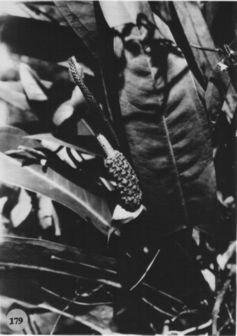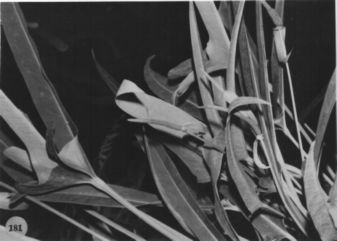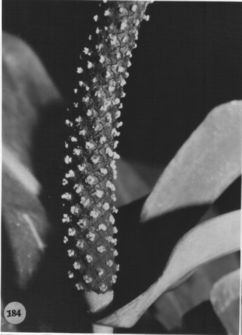






Anthurium seleri Engl.,
Bot. Jahrb. Syst. 25:459. 1898. TYPE: Guatemala. Huehuelenango: near Chacula, Seler 2643 (B, holotype).
Anthurium andresloviense Matuda, Anales Inst. Biol. Univ. Nac. Mexico 36: 108. 1966. TYPE: Mexico. Oaxaca: San Andres Lovene, Munic. Miahuatlan (N of Pluma Hidalgo), 1,200 m elev., MacDougall 384 (MEXU, holotype; F, isotype).Terrestrial; internodes and leaf scars obscured by cataphylls and roots; roots numerous, medium thick, descending; cataphylls subcoriaceous, 6-11 cm long, sometimes faintly tinged reddish at apex, sometimes with long hair-like subapical apiculum, drying reddish brown, splitting at base, remaining intact at apex and persisting.
LEAVES with petioles erect to spreading, (7) 14-48 cm long, 4-6 mm diam., sharply and shallowly sulcate; geniculum 1.4-1.6 cm long; blade moderately thick, narrowly triangular to oblong-lanceolate or oblong-lanceolate with hastate posterior lobes, gradually acuminate at apex, usually broadly lobed, sometimes deeply lobed or ± rounded to truncate at base, (9)24-50 cm long, (5)10-50 cm wide, broadest at base; anterior lobe (8.5)25-41 cm long, margins convex to straight; posterior lobes 6-18 cm long, from sinus to outermost point; the sinus usually parabolic, sometimes arcuate with petiole decurrent, broader than deep, rounded at apex; the upper surface matte to semiglossy, the lower surface matte; midrib bluntly and weakly raised above, convexly raised below; basal veins 2-5 pairs, the second to fifth coalesced to 8 cm; posterior rib straight, naked, turned up on outer margin; primary lateral veins 9-11 per side, departing midrib at 45°-50° angle, usually straight, loop-connecting to collective vein, sunken and nearly obscure above, flat below; collective vein arising from one of the lowermost basal veins, sunken above, flat below, 2-6 mm from margin.
INFLORESCENCE erect-spreading, longer than leaves; peduncle 25-50(86) cm long, terete, sometimes faintly tinged with purple; spathe moderately thin, lanceolate, pale green, tinged reddish at base, 5-9 cm long, 0.9-1.5 cm wide, long-acuminate at apex, acute to rounded at base, inserted on peduncle at 50°-70° angle; stipe 4-20 mm long in front, 1-15 mm long in back; spadix green, tinged red-violet along inner margins of tepals, 6-13 cm long, 6-8 mm diam. at base, 2-4 mm diam. at apex; flowers rhombic to sub-4-lobed, 3.5-3.7 mm long, 3-3.5 mm wide, the sides ± straight to gradually sigmoid; 4-5 flowers visible in the principal spiral, 4-10 flowers visible in the alternate spiral; tepals matte, minutely punctate, abundant droplets when stamens begin to emerge, lateral tepals 1.4-1.6 mm wide, the inner margin straight to convex, ± transparent; pistils emergent to 4 mm, white to pale green with minute purple puncta-tions; stigma linear, ca. 0.5 mm long; stamens emerging slowly from the base in a ± complete sequence, lateral stamens first followed by alternates, the basal spirals complete as lateral stamens emerge above middle, exserted on short filaments, ca. 0.2 mm long, soon retracting and held in a circle at edge of pistil; anthers tan, 0.5-1 mm long, 0.7-1.2 mm wide, inclined over pistil; thecae ellipsoid, slightly divaricate; pollen white to pale yellow.
INFRUCTESCENCE pendent; berries red, obovoid, 6-7 mm long, 4 mm wide. Figs. 179, 181, and 184.
Anthurium seleri is known primarily from a relatively small geographic
area ranging from eastern Mexico (central Chiapas) to adjacent areas of
west central Guatemala in the Department of Huehuetenango at elevations
from 700 to 1,900 m. The species has also rarely been collected in southern
Oaxaca in the Sierra Madre del Sur, and while these appear to be outlying
populations, both regions probably consist of vegetation that is "bosque
pino-encino" on the Mexican vegetation maps, which arc generally quite
arid. Plants are usually found growing on rocks or on steep cliffs in shaded
canyons but have also been found in open almost deforested areas.
The species is a member of section Belolonchium and is
recognized by its coriaceous blades, which are either oblong or narrowly
triangular with usually little or no development of posterior lobes or
with the posterior lobes directed outward almost at a 90° angle from
the midrib. An extreme development of the posterior lobes is found in some
collections from the northern and western part of the range of the species
and a few collections such as Car/son 1523, Reko 6203, and MacDougall
686 have posterior lobes of the blade almost as long as the anterior
lobe. An interesting feature exhibited by A. seleri is that while
most collections dry matte and greenish, some collections, such as Croat
46505, dried brown with the surfaces glossy. Since no other differences
were apparent it is assumed that these differences were a matter of differences
in drying. Anthurium seleri collections with well developed posterior
lobes can be confused with collections of A. berriozabalense.
See the discussion following that species for ways of distinguishing the
two species. The designated type of A. andresloviense (MacDougall 384)
represents a mixed collection. Specimens from MEXU, numbers 59608 and 59838
correspond to the type description and to the photograph, respectively,
presented by Matuda. Another MacDougall collection of 384 has been
assigned the number 384A. It is actually A.
ovandense. As mentioned in the introductory paragraph, MacDougall
had often recollected what he believed to be the same plants again; when
he did, he had the unusual practice of assigning them the same number as
he did the first time he collected the plant. In this case the plants he
re-coDccted were in fact of some other species, even though they both have
similar leaves and were both collected at San Andres Lovene.
 |
 |
 |
Mexico Chiapas: Mpo. Cintalapa, 920 m,, 2 Nov 1988, Breedlove &
Daniel 70913 (CAS).
Mexico Chiapas: Mpo. Cintalapa, 1850 m,, 3 May 1988, Breedlove 67071
(CAS).
Mexico Chiapas: 880 m,, 25 Oct 1988, Breedlove 70679 (CAS).
Mexico Chiapas: 1000 m,, 9 July 1977, Thomas B. Croat 40541 (MO).
Mexico Chiapas: 850 m,, 2 Oct 1995, A. Perez-Farrera 773A (MO).